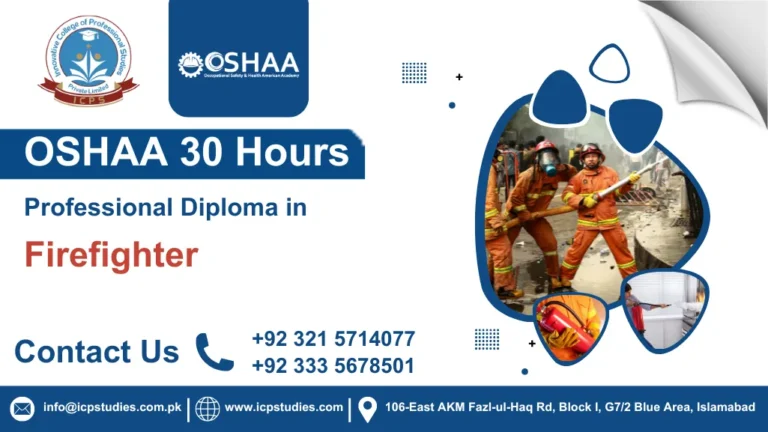Don’t compromise on safety – choose OSHA General Industry 30 Hours
Are you working in the general industry sector and concerned about the safety and health of your workers? Do you want to ensure that your workplace is compliant with the Occupational Safety and Health Administration (OSHA) regulations? Then the OSHA General Industry 30 Hours Course is the right fit for you.
If you’re a worker in the general industry or a safety professional, you may have heard of the OSHA General Industry 30 Hours Course. But what exactly is it, and why is it important?
Our comprehensive course covers all aspects of safety regulations and guidelines set forth by the Occupational Safety and Health Administration (OSHA). From hazard communication to electrical safety, our expert instructors provide you with the knowledge and skills you need to maintain a safe and productive work environment.
Our course is designed to be flexible and convenient, allowing you to complete the training at your own pace and on your own schedule. And with our 24/7 support, you can rest assured that you will have all the resources you need to succeed.
Don’t let safety concerns hold you back in your career. Enroll in our OSHA General Industry 30 Hours course today and take the first step towards a safer, more successful future.
All About OSHA General Industry 30 Hours Course
Course Overview
The OSHA General Industry 30 Hours Course, developed by the Occupational Safety and Health Administration (OSHA), serves as a comprehensive training program aimed at educating workers and safety professionals about the various hazards and safety protocols inherent in general industry workplaces. Covering a broad spectrum of topics including electrical safety, hazard communication, personal protective equipment (PPE), machine guarding, and more, this course is a cornerstone for ensuring workplace safety.
Typically spanning over four days, the course integrates classroom instruction with hands-on training to provide participants with a well-rounded learning experience. Upon successful completion, participants receive a course completion card recognized by OSHA and numerous employers as evidence of their training.
The significance of the OSHA General Industry 30 Hours Course cannot be overstated. With workplace safety being a paramount concern for both employers and employees, this course equips participants with the knowledge and skills necessary to identify and mitigate potential hazards, thereby reducing the risk of workplace accidents, injuries, and fatalities.
Moreover, many employers mandate their workers to undergo this training as part of their onboarding process or ongoing training requirements. Completion of the course not only ensures workers’ safety on the job but also underscores their dedication to workplace safety, earning them respect from their employer and colleagues alike.
In essence, the OSHA General Industry 30 Hours Course represents a valuable investment for individuals employed in the general industry. By undertaking this training, workers can augment their safety proficiency, safeguard themselves and their coworkers from workplace hazards, and reaffirm their commitment to promoting a safe work environment.
The entry requirements for the OSHA General Industry 30-Hour Course typically include:
- Age Requirement:
- Participants should be at least 18 years old.
- Basic Literacy Skills:
- Candidates should be able to read and understand English, as course materials and instruction are primarily in English.
- No Formal Prerequisites:
- There are generally no specific formal prerequisites; however, some prior experience in a workplace or knowledge of general safety practices is beneficial.
- Commitment to Attendance:
- Participants must be able to commit to the full duration of the course, which usually spans multiple days.
- Employer Support:
- While not mandatory, having employer support can be beneficial, especially for implementing safety practices learned in the course.
- Personal Protective Equipment (PPE):
- Depending on the training environment, participants may need to bring their own personal protective equipment for any practical components.
For the most accurate and specific information, it is advisable to consult the specific training provider or organization offering the OSHA General Industry 30-Hour Course, as requirements may vary.
Mandatory Units
Learning Outcomes
Discover the key learning outcomes of the OSHA General Industry 30-Hour course, including safety regulations, hazard recognition, and emergency response procedures.
OSHA General Industry 30-Hour course is comprehensive course covers a range of essential topics that are vital for maintaining a safe and healthy workplace.
Here are the key learning outcomes you can expect from the OSHA General Industry 30-Hour course:
Module 1: Introduction to OSHA
- Understand the objectives, scope, and importance of OSHA regulations.
- Identify the key roles and responsibilities of employers and employees under OSHA standards.
- Recognize how OSHA standards contribute to workplace safety and compliance.
Module 2: Managing Safety and Health
- Develop strategies to manage workplace safety and health effectively.
- Learn to implement safety programs that reduce workplace hazards.
- Promote a culture of health and safety among employees.
Module 3: Walking & Working Surfaces, including Fall Protection
- Identify hazards related to walking and working surfaces.
- Apply fall protection methods and preventive measures.
- Conduct risk assessments for elevated work areas.
Module 4: Emergency Action Plan
- Understand the purpose and components of an emergency action plan.
- Develop procedures for responding to workplace emergencies.
- Ensure effective communication and coordination during incidents.
Module 5: Electrical Safety
- Recognize electrical hazards in the workplace.
- Apply safe work practices for handling electrical equipment.
- Understand grounding, circuit protection, and lockout procedures.
Module 6: Personal Protective Equipment (PPE)
- Identify types of PPE required for various workplace hazards.
- Learn proper selection, use, and maintenance of PPE.
- Ensure compliance with OSHA PPE standards.
Module 7: Materials Handling
- Understand safe methods for lifting, carrying, and storing materials.
- Identify ergonomic risks and implement preventive measures.
- Apply proper handling procedures to prevent injuries and accidents.
Module 8: Hazard Communication
- Understand the OSHA Hazard Communication Standard (HCS).
- Identify hazardous chemicals and proper labeling requirements.
- Develop safety data sheet (SDS) awareness and employee training.
Module 9: Hazardous Materials
- Recognize the types of hazardous materials used in the workplace.
- Apply safe storage, handling, and disposal procedures.
- Understand environmental and health impacts of hazardous materials.
Module 10: Permit-Required Confined Space
- Identify confined spaces and associated hazards.
- Implement entry procedures, permits, and emergency rescue plans.
- Ensure compliance with OSHA confined space regulations.
Module 11: Lockout / Tagout
- Understand the principles of energy control and lockout/tagout procedures.
- Apply procedures to prevent accidental machine startup during maintenance.
- Conduct audits to verify compliance with lockout/tagout requirements.
Module 12: Machine Guarding
- Identify machinery hazards and the need for guarding.
- Implement appropriate guard systems for various equipment.
- Evaluate guard effectiveness to ensure worker safety.
Module 13: Welding and Cutting
- Recognize hazards associated with welding and cutting operations.
- Apply safety measures, including PPE and ventilation requirements.
- Implement fire prevention and control procedures during welding tasks.
Module 14: Hazardous Substances & Industrial Hygiene
- Identify chemical, physical, and biological workplace hazards.
- Apply industrial hygiene principles to minimize exposure.
- Monitor and control workplace environments to protect worker health.
Module 15: Bloodborne Pathogens
- Understand risks related to bloodborne pathogens in the workplace.
- Apply universal precautions and infection control measures.
- Implement exposure control plans and proper medical reporting.
Module 16: Ergonomics
- Recognize ergonomic hazards in workplace tasks.
- Apply ergonomic solutions to prevent musculoskeletal injuries.
- Evaluate workstations and job tasks to improve employee comfort and safety.
Module 17: Fall Protection
- Identify fall hazards in different work environments.
- Select and use appropriate fall protection systems and equipment.
- Conduct inspections and training to maintain fall protection programs.
Module 18: Safety and Health Programs
- Develop and implement comprehensive workplace safety and health programs.
- Monitor and review program effectiveness.
- Promote continuous improvement in organizational safety culture.
Module 19: OSHA Recordkeeping
- Understand OSHA recordkeeping requirements for workplace injuries and illnesses.
- Maintain accurate documentation of incidents, inspections, and corrective actions.
- Use records to identify trends and improve safety programs.
Module 20: Process Safety Management
- Learn key elements of process safety management (PSM).
- Apply hazard analysis and risk management techniques for process operations.
- Ensure compliance with OSHA PSM regulations to prevent catastrophic events.
Module 21: Asbestos in Workplace
- Identify asbestos-containing materials and associated health risks.
- Apply safe handling, removal, and disposal procedures.
- Comply with OSHA and environmental regulations related to asbestos.
Module 22: Scaffolds
- Understand hazards associated with scaffold use.
- Implement safety measures, including erection, inspection, and fall prevention.
- Ensure compliance with OSHA scaffold standards.
Module 23: HAZWOPER
- Understand OSHA’s Hazardous Waste Operations and Emergency Response (HAZWOPER) standards.
- Apply safe procedures for hazardous waste operations.
- Respond effectively to chemical spills and emergency situations.
By completing the OSHA General Industry 30-Hour course, you will gain the knowledge and skills needed to ensure the safety and health of yourself and your colleagues in the workplace. Start your journey to becoming an OSHA expert today!
This course is designed for individuals who are interested in learning about occupational safety and health hazards in general industry and how to identify, prevent, and control them.
Employees in General Industry
- Individuals working in sectors such as manufacturing, warehousing, healthcare, logistics, and other general industry environments.
- Those who want to gain a comprehensive understanding of occupational safety and health hazards specific to their workplace.
- Employees responsible for following safety procedures and contributing to a culture of safety.
- Workers who aim to recognize, prevent, and control workplace hazards to protect themselves and their colleagues.
Supervisors and Team Leaders
- Individuals who oversee teams and ensure daily operations are carried out safely.
- Supervisors tasked with implementing workplace safety programs, policies, and OSHA compliance requirements.
- Those seeking to strengthen their ability to monitor employees’ adherence to safety practices and manage risk effectively.
- Leaders responsible for accident prevention, incident investigations, and promoting safety awareness among their team.
Safety Professionals and Consultants
- Occupational safety specialists who design, implement, and maintain health and safety programs within organizations.
- Safety consultants who provide expert guidance on regulatory compliance, risk management, and safety audits.
- Professionals looking to update or enhance their knowledge of OSHA standards and best practices for workplace safety.
- Trainers and educators who need to understand general industry hazards to deliver accurate and practical safety training.
Human Resources and Compliance Personnel
- HR professionals responsible for staff training, onboarding, and ensuring compliance with workplace safety regulations.
- Personnel involved in developing organizational safety policies, procedures, and risk management strategies.
- Individuals who need to coordinate between management, employees, and regulatory bodies to maintain a safe workplace.
Aspiring Health and Safety Leaders
- Individuals aiming to advance their careers in occupational safety and health management.
- Those seeking formal OSHA knowledge to take on more responsibility in safety program development, monitoring, and auditing.
- Professionals who want to lead initiatives that reduce workplace injuries, illnesses, and compliance risks.
Overall Learning Objective for Target Audience
By completing this course, learners will:
- Acquire in-depth knowledge of general industry hazards and OSHA standards.
- Be equipped with practical skills to prevent, control, and manage workplace risks effectively.
- Gain the confidence to contribute to a safe and healthy work environment for themselves, their colleagues, and the organization as a whole.
FAQs Related to OSHA General Industry 30 Hours Course







